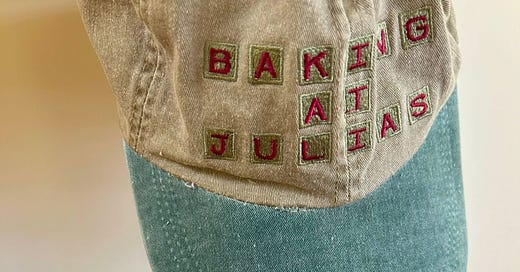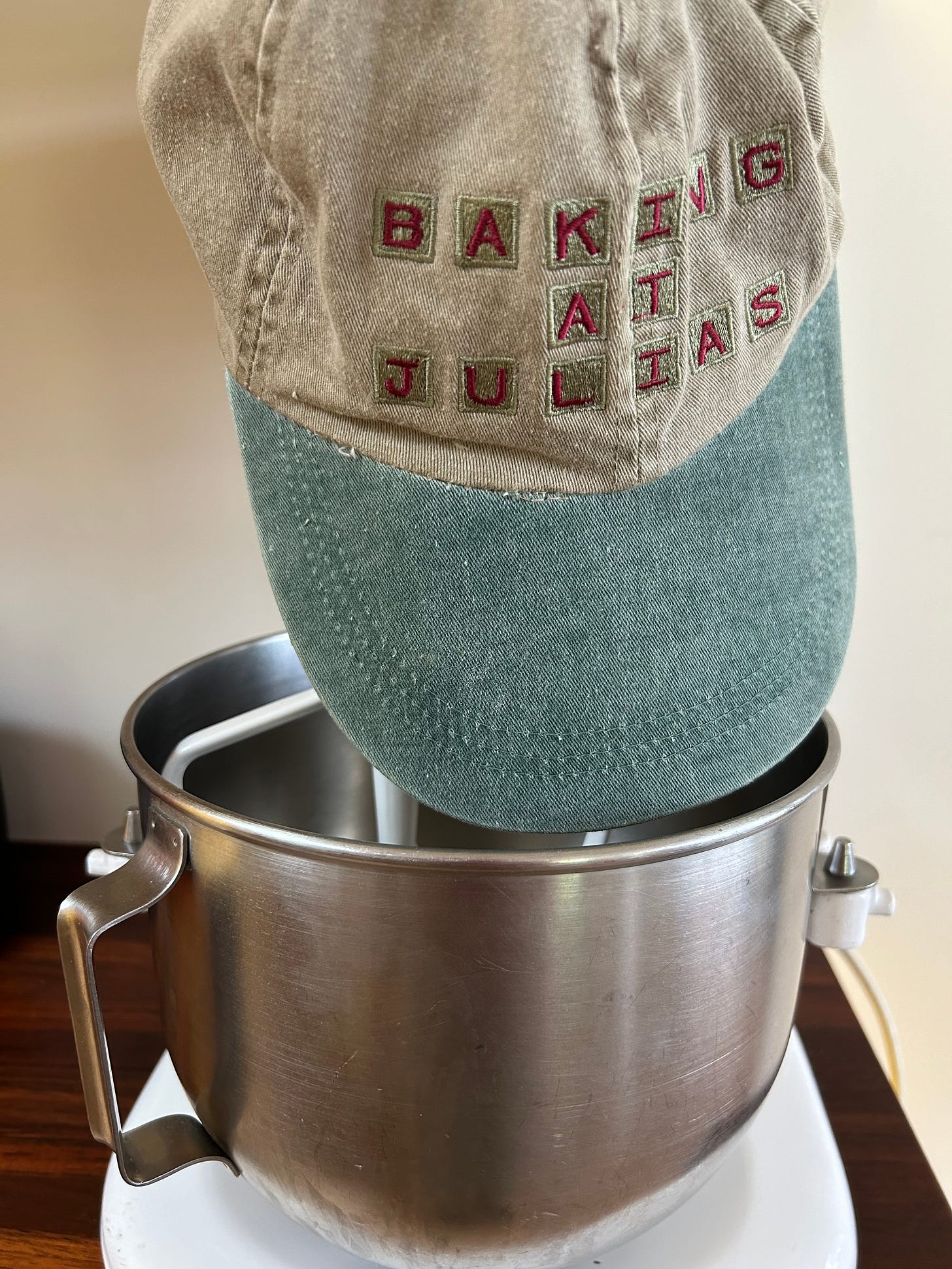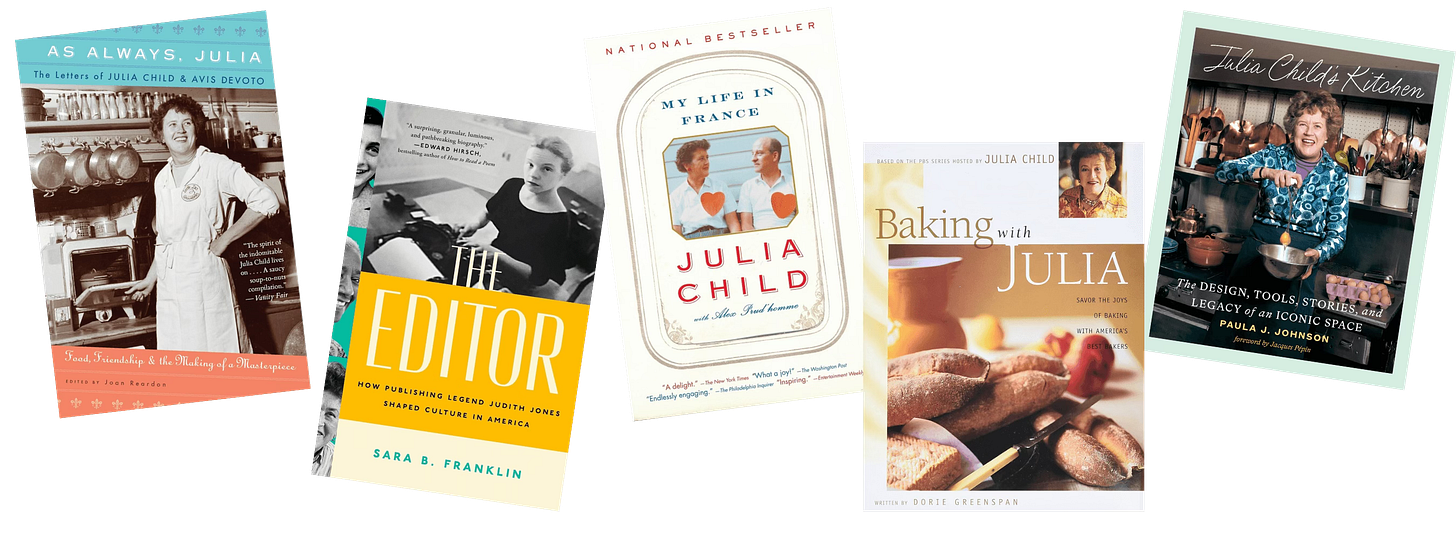3 stories for Julia Child on her birthday (+ 3 recipes)
Never leave home without her wit and wisdom
Hello! Hello!
Stop me if you’ve heard these stories before. In the great “one day” I’ll write these properly and collect them and bunches of others in some form or another — Michael’s been urging me to do this for years — but for today, they’re coming to you because it’s the moment. If they’re not polished, I hope you’ll understand. The woman I’m celebrating might or might not have understood — her standards were pinnacle high. Today’s newsletter is dedicated to Julia Child, who would have been 112 on August 15.
When I worked with Julia Child …
Whenever I start a conversation with the line, “when I worked with Julia Child … ” I get this little tingle, in part because it all seems so improbable, even now, and in part because it sounds like I’m trying on a more confident persona than my own. It was 30 years ago that I began working with Julia - how I met her and what lead up to me arriving at her house in Cambridge, MA to begin our project is for that great “one day.” But I was at her house so that we could lay out Baking with Julia, the PBS series that we’d shoot in the summer and the book that I’d write for publication soon after. From that first meeting until she died in 2004, we kept in touch and created stories. For today, I’ll tell you three short ones, not because they are necessarily the best, but because a girl’s gotta start somewhere.
Sandwiches in Julia’s Kitchen
Julia’s kitchen was the heartbeat of her rambling house. It’s been moved to the Smithsonian National Museum of American History and the story of how everything from that kitchen — the dust in the drawers included — was catalogued and reconstructed is told in fascinating detail in curator Paula Johnson’s soon-to-be-published book, Julia Child’s Kitchen (you can pre-order on Amazon or Bookshop.org).

Although the house had a front door — you can see it in some of Julia’s shows — I don’t ever remember anyone using it. You entered through the side door, climbed a couple of stairs and there you were, in the famous kitchen. That’s where most of our meetings took place and that’s where, early on, I remember an editorial meeting that started early in the morning with coffee and later broke for lunch. That’s when Julia rose from her favorite chair — one that she and Paul had brought back from Norway — went to the pantry and returned with cans of tuna. I hadn’t thought about what lunch would be, still I guess I didn’t expect tuna. As Julia mashed the tuna and stirred in the mayo, she asked me to cut some celery. I know it was silly, but I was nervous — it may just have been chopping a few stalks of celery, but I thought of it as cooking for Julia, and so I worked to make all the pieces the same size. By the time I was almost through with my job, Julia had cut the tomato and onion, the cornichons, capers and olives, gotten out the English muffins and washed the lettuce. She just smiled at me — I think I wasn’t the first jittery celery-chopper she’d come across. I never got faster at cutting, chopping or anything else in the kitchen, but as I got to know Julia better, I did stop worrying about perfection when I was cooking with her. Julia loved for things to be right, but for her, the most important thing about any dish was how it tasted, and my uneven celery tasted just fine.
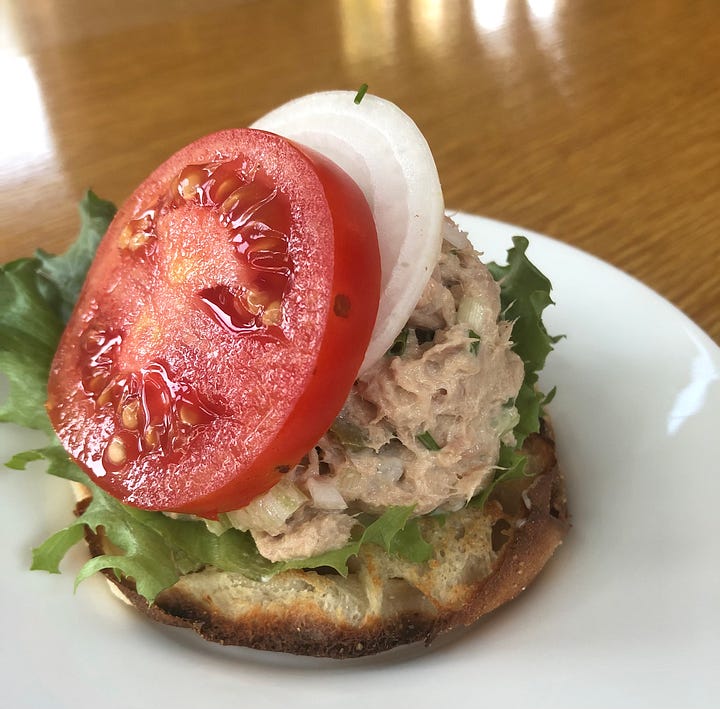
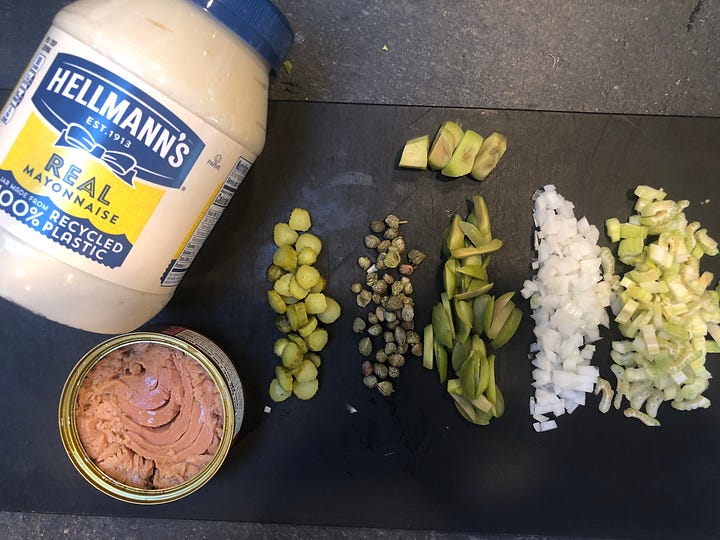
Never leave home without it
As kind and generous and encouraging as Julia was — and she was that in abundance — I was a wreck during the two months that I lived in Cambridge and we were shooting Baking with Julia. I had a lot to do, I knew I’d have even more to do when I returned home to write the book and I understood that there was so much riding on my doing the job well. And so, in this state, I didn’t give a moment’s thought to how I looked. For most of the time that I was there, my hair was too long, my nails were ragged and I think I wore the same outfit on repeat. As for makeup, in those days I’d wear eyeliner and blush, but life that summer was too hectic for even that. And then one day, when Julia and I had snuck out for a little fun — Julia’s idea of fun was going to the supermarket — she put her arm around me and said, “You know, you really should never leave the house without lipstick — you never know who you might meet.” When I told her that I never wore lipstick, she said, “You should! And I’m going to buy you lipstick today.”
And she did — Julia marched into Walgreen’s and bought me the same 99-cent lipstick she used. The case was green and I can’t remember what color the lipstick was, but that didn’t make any difference — the lipstick, which stayed on for 24 hours, changed color depending on, hmm. What? A person’s chemistry? Her aura? It was the mood ring of lipstick. I’m not sure what mood orange is, but that’s the color the lipstick she decided I needed, and it was hideous on me. Even Julia didn’t like it. But I had to live with it — and she had to look it — for a full 24 hours. That stuff really did last! It took me another 10 years to come around to wearing lipstick. Most days, I never leave home without it. And on all days, I never, never wear orange.
💋 xoxoDorie is a reader-supported newsletter. Upgrade and be ready for whomever you might meet! 💋
Send us a message request via Substack chat if you need help with your membership, or you can manage your subscription directly in your account at this link.
You don’t know until you’ve tried it
If you’ve seen even one episode of any Julia program, then you know that she’s funny. Sometimes laugh-out-loud funny, more often slyly funny, knowingly fun, sophisticatedly funny, amusing and ready to find the humor in everything. Julia had the timing of a stand-up comic. It’s part of what made her so immediately beloved by American audiences. But behind that humor was an intelligence as sharp as a croissant shard and a limitless curiosity. Also, she worked hard! My office at the Irving Street house was called “The Red Room” because the paintings in the room, all by Paul Child, were shades of red. In addition, it was where Julia had hair and makeup done each morning. And no matter how early I got to my office, Julia was already there. She’d have a cup of coffee next to her, the news on the tv in front of her and all around her the morning newspapers. She was interested in the world and even though we were pretty much confined to the house for the two months of shooting, she followed every beat of the outside world. And every beat of every one of our show’s guests and recipes. Julia knew she had to entertain her audience — that came easily to her, since she was generous and caring, gracious and welcoming. But she thought of teaching as her primary job, and so she made sure that she knew her subject thoroughly before she taught anyone anything. And she wanted to teach everyone everything. One morning, a few weeks before we started shooting, Julia, an avid breadbaker, called to ask if I had a bread machine, a tool that was pretty new on the scene then. I didn’t, I didn’t have plans to get one and I confessed that it didn’t interest me. “It should!” she told me. “Maybe it’s a piece of junk, but maybe it’s something that will get people to make their own bread more often.” And so, that morning we both went out and bought machines and a few weeks later, Lora Brody, a bread machine ace, was prepping an episode of the show in Julia’s basement with a dozen bread machines spinning out a yeasty tattoo that echoed up the staircase. After I’d made the recipes for the book, I gave my machine to my friend Pearl — it just wasn’t for me — but Julia kept hers. She didn’t like the hole that the machine made in each loaf and didn’t like that the shape of the loaf was uniform, but she discovered how to bend the machine to her preferences: She used it for mixing and kneading, then shaped and baked the loaves traditionally. It was an all-Julia move — she was top of the trend, and she brought all of us along with her.
The other side of the icon — in print
I still can’t believe that I was lucky enough to work with Julia, lucky enough to have her in my life for all the years after our work was over. As much as we talked and as well as I got to know her, every time I read a book about her, I learn more about her and miss her more. Here are a few about Julia that I love and that take us behind the scenes of the woman and the books of hers that we cherish.
⁌ As Always, Julia edited by Joan Reardon
This is my favorite Julia book. It’s a collection of the letters that Julia and Avis DeVoto wrote to one another while Julia was working on Mastering the Art of French Cooking. Avis was crucially instrumental in getting it published and their letters document the hard work — the extremely hard, creative and often tedious work — that went into making the book. These two women were extraordinary — they’re also great company!
Get on Amazon | Bookshop.org
⁌ The Editor by Sara B. Franklin
I’ve talked about this book before — it’s about Judith Jones, who championed and published Mastering the Art of French Cooking, and it gives us a picture of what it takes to bring a book into the world.
Get on Amazon | Bookshop.org
⁌ My Life in France by Julia Child with Alex Prud’homme
A delightful memoir recounting Julia’s introduction to France and her life there with her beloved husband, Paul Child.
Get on Amazon | Bookshop.org
Oh, and you might want to read Baking with Julia, the book I wrote to be published with the television series. With recipes from 27 bread bakers and pastry chefs — more recipes than were in the 26 episodes — the book works as a teaching text, just as Julia hoped it would.
As Julia would say, BON APPETIT!
👋 Say hello and share what you're making on Facebook and Instagram.
📚 You can find more recipes in my latest book Baking with Dorie.


